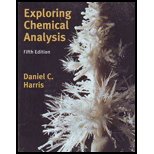
(a)
Interpretation:
Color of
Concept Introduction:
Titration is an analytical method of quantitative chemical analysis which determines the concentration of the analyte. A reagent called titrant, is prepared as a standard solution. This titrant reacts with titrand (analyte) solution to determine the concentration of the analyte. The volume of titrant required for titration is termed as the titration volume.
Iodometric titration is a type of titration reaction in which iodides reacts with another oxidizing agent in acidic or neutral medium. As a result of this, iodides are converted to iodine and this formed iodine is back titrated against another standard reducing agent (usually sodium thiosulphate) of known concentration.
(b)
Interpretation:
Mass of
Concept Introduction:
Refer to part (a).
(c)
Interpretation:
Whether starch indicator is added at beginning or near end point of the titration has to be explained.
Concept Introduction:
Refer to part (a).
Want to see the full answer?
Check out a sample textbook solution
 ChemistryChemistryISBN:9781305957404Author:Steven S. Zumdahl, Susan A. Zumdahl, Donald J. DeCostePublisher:Cengage Learning
ChemistryChemistryISBN:9781305957404Author:Steven S. Zumdahl, Susan A. Zumdahl, Donald J. DeCostePublisher:Cengage Learning ChemistryChemistryISBN:9781259911156Author:Raymond Chang Dr., Jason Overby ProfessorPublisher:McGraw-Hill Education
ChemistryChemistryISBN:9781259911156Author:Raymond Chang Dr., Jason Overby ProfessorPublisher:McGraw-Hill Education Principles of Instrumental AnalysisChemistryISBN:9781305577213Author:Douglas A. Skoog, F. James Holler, Stanley R. CrouchPublisher:Cengage Learning
Principles of Instrumental AnalysisChemistryISBN:9781305577213Author:Douglas A. Skoog, F. James Holler, Stanley R. CrouchPublisher:Cengage Learning Organic ChemistryChemistryISBN:9780078021558Author:Janice Gorzynski Smith Dr.Publisher:McGraw-Hill Education
Organic ChemistryChemistryISBN:9780078021558Author:Janice Gorzynski Smith Dr.Publisher:McGraw-Hill Education Chemistry: Principles and ReactionsChemistryISBN:9781305079373Author:William L. Masterton, Cecile N. HurleyPublisher:Cengage Learning
Chemistry: Principles and ReactionsChemistryISBN:9781305079373Author:William L. Masterton, Cecile N. HurleyPublisher:Cengage Learning Elementary Principles of Chemical Processes, Bind...ChemistryISBN:9781118431221Author:Richard M. Felder, Ronald W. Rousseau, Lisa G. BullardPublisher:WILEY
Elementary Principles of Chemical Processes, Bind...ChemistryISBN:9781118431221Author:Richard M. Felder, Ronald W. Rousseau, Lisa G. BullardPublisher:WILEY





